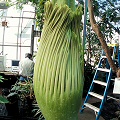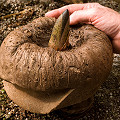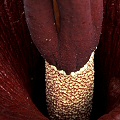Q: Amorphophallus (the corpse flower), Sauromatum, and other stinky aroids
A: Repeat after me, "These are not carnivorous plants."
What is this fascination that people have about stinking plants? It must be indicative of
something fatally flawed about our species. I just cannot figure it out.
But anyway, in the Arum family (Araceae) there are a number of plant genera
that have big flowers that mimic dead, rotting, stinking gunk. They do
this so that insects of the right sort (a relative term, I suppose) will buzz in from far and wide in search of nasty, smelly
things to crawl around on. Pollination occurs. The plant gets what it wants.
The plant from this group that I am most frequently asked about is, of course,
Amorphophallus titanum. For a few months of the year this plant
spends its time underground as a dormant bulb. (Imagine something that
looks like a grocery-store water chestnut, but that is the size of a preschooler.)
Most years it produces a huge, squamous stalk that is taller than a star basketball player.
This stalk is topped by a feathery grouping of leaves.
Before I proceed, I know I will get dozens of angry emails from outraged botanists unless I point out that
in truth, the entire stalk and its crowning leafy ensemble is but a single leaf.
Back to the Amorphophallus. Every now and then, it forgoes
producing a leaf, and in its place makes
a single flower. This flower has a huge cowl (called a spathe) and a bizarre...uh...columnar
pillar (called a spadix) that pokes out of the cowl in an embarrassingly
erect way and extends skywards for about two meters (six feet). It is
crazy big. But even more spectacular than the flower's appearance is the
smell. A common English name for this plant is "corpse flower,"
and indeed this flower's stench is what I expect Hannibal Lecter's compost
pile would smell like on a hot August afternoon.
I have had the pleasure of observing Amorphophallus titanum in flower
a number of times, and each event was astonishing.
Standing by the plant, its smell was horrible by any standard. Then, suddenly, it would
pump out an extra snootful of stink, and you would have to swallow hard to keep your food down.
The first time my wife and I smelled one
of these plants, it nearly made her hurl---she had to run out of the greenhouse during one of the
particularly vigorous outpourings of odiferous horror. That is her, to the right, wearing a gas mask.
Greenhouse curators love the rare-flowering Amorphophallus titanum because
if they can coerce one to flower, they can be sure that their
conservatory will be on the evening news. Watch while
the news staff smirks about the fact that this plant looks like, well, what its Latin
name means---"huge funny-shaped penis".
By the way, how about that goofy Latin name, Amorphophallus titanum?
Gotta love these botanists. Get some fresh air, maybe meet people, you freaks!
The two photographs to the right are of Amorphophallus rivieri, a mere
dwarf cousin of the corpse flower. Even though its flower is only a few feet tall,
the smell is so solidly rank that it will grind your eyes deep into your skull and send your teeth in after them.
To take the photographs to the right, I had to get very close to the belchingly rank flower; my hair
smelled bad for hours.
Another commonly encountered stinky aroid is a species of Sauromatum,
sometimes sold as the Voodoo lily. (Sounds like a slur against our Haitian friends, if you ask me.)
While just a foot or so tall, it has all the attributes of its more colossal relatives. It makes for a wonderful
gag gift (pun intended). I gave a few corms to my mum one year. Several months later it flowered, and
I received a very angry call from her. Heh heh heh.
Page citations: Mabberley, D.J. 1987; Rice, B.A. 2006a; personal observations.






